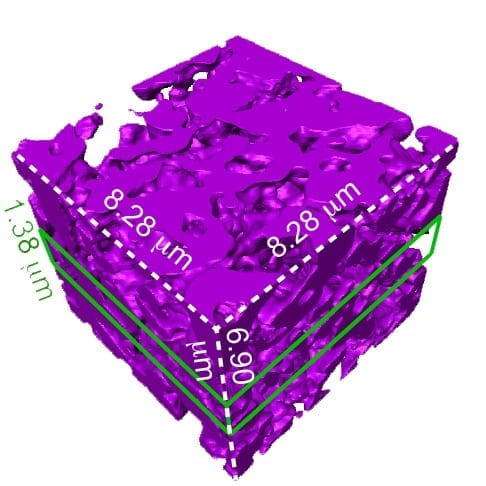
Silicon-based invention is tiny, soft, wirelessly functional
In the campy 1966 science fiction movie “Fantastic Voyage,” scientists miniaturize a submarine with themselves inside and travel through the body of a colleague to break up a potentially fatal blood clot. Micro-humans aside, imagine the inflammation that metal sub would cause.
Ideally, injectable or implantable medical devices should not only be small and electrically functional, they should be soft, like the body tissues with which they interact. Scientists from two UChicago labs set out to see if they could design a material with all three of those properties.
The material they came up with, the subject of a study published June 27 in Nature Materials, forms the basis of an ingenious light-activated injectable device that could eventually be used to stimulate nerve cells and manipulate the behavior of muscles and organs.
“Most traditional materials for implants are very rigid and bulky, especially if you want to do electrical stimulation,” said Bozhi Tian, an assistant professor in chemistry whose lab collaborated with that of neuroscientist Francisco Bezanilla, the Lillian Eichelberger Cannon Professor of Biochemistry and Molecular Biology.
The new material, in contrast, is soft and tiny, composed of particles just a few micrometers in diameter—far less than the width of a human hair—that disperse easily in a saline solution so they can be injected. The particles also degrade naturally inside the body after a few months, so no surgery would be needed to remove them.
Nanoscale ‘sponge’
Each particle is built of two types of silicon that together form a structure full of nano-scale pores, like a tiny sponge. And like a sponge, it is also squishy—a hundred to a thousand times less rigid than the familiar crystalline silicon used in transistors and solar cells. “It is comparable to the rigidity of the collagen fibers in our bodies,” said Yuanwen Jiang, Tian’s graduate student. “So we’re creating a material that matches the rigidity of real tissue.”
The material constitutes half of an electrical device that creates itself spontaneously when one of the silicon particles is injected into a cell culture, or, eventually, a human body. The particle attaches to a cell, making an interface with the cell’s plasma membrane. Those two elements together—cell membrane plus particle—form a unit that generates current when light is shined on the silicon particle.
“You don’t need to inject the entire device; you just need to inject one component,” said João L. Carvalho-de-Souza, a postdoctoral scholar in Bezanilla’s lab. “This single particle connection with the cell membrane allows sufficient generation of current that could be used to stimulate the cell and change its activity. After you achieve your therapeutic goal, the material degrades naturally. And if you want to do therapy again, you do another injection.“
The scientists built the particles using a process they call nano-casting. They fabricate a silicon dioxide mold composed of tiny channels, or “nano-wires,” about seven nanometers in diameter and connected by much smaller “micro-bridges.” Into the mold they inject silane gas, which fills the pores and channels and decomposes into silicon.
And this is where things get particularly cunning. The scientists exploit the fact the smaller an object is, the more the atoms on its surface dominate its reactions to what is around it. The micro-bridges are minute, so most of their atoms are on the surface. These interact with oxygen that is present in the silicon dioxide mold, creating micro-bridges made of oxidized silicon gleaned from materials at hand. The much larger nano-wires have proportionately fewer surface atoms, are much less interactive and remain mostly pure silicon.
“This is the beauty of nanoscience,” Jiang said. “It allows you to engineer chemical compositions just by manipulating the size of things.”
Web-like nanostructure
Finally, the mold is dissolved. What remains is a web-like structure of silicon nano-wires connected by micro-bridges of oxidized silicon that can absorb water and help increase the structure’s softness. The pure silicon retains its ability to absorb light.
The scientists have added the particles onto neurons in culture in the lab, shone light on the particles, and seen current flow into the neurons which activates the cells. The next step is to see what happens in living animals. They are particularly interested in stimulating nerves in the peripheral nervous system that connect to organs. These nerves are relatively close to the surface of the body, so near-infra-red wavelength light can reach them through the skin.
Tian imagines using the light-activated devices to engineer human tissue and create artificial organs to replace damaged ones. Currently, scientists can make engineered organs with the correct form but not the ideal function.
To get a lab-built organ to function properly, they will need to be able to manipulate individual cells in the engineered tissue. The injectable device would allow a scientist to do that, tweaking an individual cell using a tightly focused beam of light like a mechanic reaching into an engine and turning a single bolt. The possibility of doing this kind of synthetic biology without genetic engineering is enticing.
“No one wants their genetics to be altered,” Tian said. “It can be risky. There’s a need for a non-genetic system that can still manipulate cell behavior. This could be that kind of system.”
Jiang did the material development and characterization on the project, while Carvalho-de-Souza did the biological component of the collaboration in Bezanilla’s lab. They were, said Tian, the “heroes” of the work.
Learn more: Injectable biomaterial could be used to manipulate organ behavior
The Latest on: Light-activated injectable device
[google_news title=”” keyword=”light-activated injectable device” num_posts=”10″ blurb_length=”0″ show_thumb=”left”]
via Google News
The Latest on: Light-activated injectable device
- The best smart home devices in 2024on April 12, 2024 at 1:01 am
the best smart home devices streamline your routine for complete convenience.
- 92K D-Link NAS Devices Open to Critical Command-Injection Bugon April 8, 2024 at 5:00 pm
"This involves chaining of a backdoor and command injection to achieve RCE." Flaws in NAS devices are serious business, as exploiting them has great potential to affect not only the device itself ...
- How To Choose The Right Red Light Therapy Deviceon April 4, 2024 at 4:31 pm
However easy they are to find, other tools, like red light therapy devices, often add a more wallet-gripping and confusing nuance to your “at-home spa” search. “You can easily incorporate ...
- What Happened?on March 31, 2024 at 5:36 pm
In this state, the core produces enough energy to light 18,000 ... The EIW (emergency injection water) is activated, and water flows into the primary loop. This is a safety device, designed ...
- The Best Red Light Therapy Devices (and Why They Work)on December 19, 2023 at 8:50 pm
What Are the Best Red Light Therapy Devices? What Is Red Light Therapy? When Should You Use Red Light Therapy Devices? Is Red Light Therapy Safe? Buying Guide: How We Chose the Best Red Light ...
- Light - Zonai Device - Zelda: Tears of the Kingdomon May 17, 2023 at 12:37 pm
Zonai devices all have unique functions that can be used to solve puzzles, build structures, and/or make vehicles. When activated with a Weapon, Arrow, or Time Bomb, the Light emits a steady beam ...
- What is red light therapy and does it work?on February 24, 2023 at 8:39 am
Even so, hundreds of light therapy devices are available online, all claiming to have myriad skin benefits. We spoke with experts to better understand what red light therapy is, how it works and ...
- Injectable Drug Delivery 2022on February 2, 2022 at 4:01 pm
Innovations in Formulation and Device Design for Enhanced Subcutaneous Delivery As Part of Europe’s leading Injectable conference series, we will assess innovations in drug product formulation ...
- Laser-Based Audio Injection On Voice-Controllable Systemson November 5, 2019 at 9:10 pm
This attack is relatively easy to prevent; manufacturers would simply need to install screens to prevent light from hitting the microphones. For devices already installed in our homes, we ...
- Light device is effective ulcer treatmenton December 18, 2018 at 9:30 am
‘A feasibility study of a novel low-level light therapy for digital ulcers in systemic sclerosis’ is published in the Journal of Dermatological Treatment The device was designed by Dr Stuart Watson, ...
via Bing News










